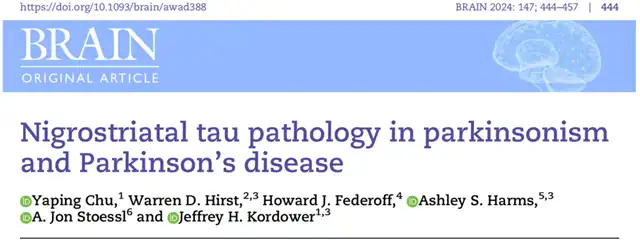Tau Pathology Emerges as Key Driver of Motor Symptoms in Parkinson’s Disease
- Normal Liver Cells Found to Promote Cancer Metastasis to the Liver
- Nearly 80% Complete Remission: Breakthrough in ADC Anti-Tumor Treatment
- Vaccination Against Common Diseases May Prevent Dementia!
- New Alzheimer’s Disease (AD) Diagnosis and Staging Criteria
- Breakthrough in Alzheimer’s Disease: New Nasal Spray Halts Cognitive Decline by Targeting Toxic Protein
- Can the Tap Water at the Paris Olympics be Drunk Directly?
Tau Pathology Emerges as Key Driver of Motor Symptoms in Parkinson’s Disease
- Should China be held legally responsible for the US’s $18 trillion COVID losses?
- CT Radiation Exposure Linked to Blood Cancer in Children and Adolescents
- FDA has mandated a top-level black box warning for all marketed CAR-T therapies
- Can people with high blood pressure eat peanuts?
- What is the difference between dopamine and dobutamine?
- How long can the patient live after heart stent surgery?
Tau Pathology Emerges as Key Driver of Motor Symptoms in Parkinson’s Disease
Scientists have long believed that α-synuclein (α-Syn) is the core pathological protein of PD. The degeneration of dopaminergic neurons in the substantia nigra, along with the accumulation of α-Syn in Lewy bodies and Lewy neurites, are considered the hallmark pathological features of PD. The presence of Lewy pathology, consisting of both Lewy bodies and neurites, is necessary for the postmortem diagnosis of PD and is considered a harbinger of neurodegeneration.
However, according to the Braak staging of PD, Stages 1 and 2 occur before nigral Lewy pathology, and during these stages, there is already a reduction in the density of tyrosine hydroxylase (TH)-positive neurons, which regulate dopamine synthesis. This suggests that neurodegenerative changes and neuronal dysfunction precede α-Syn-positive Lewy pathology in the substantia nigra. These findings challenge the core pathological status of α-Syn.
Recently, a research team from Arizona State University in the United States published their latest findings in the journal Brain [1]. They found that the nigrostriatal dopaminergic degeneration in the substantia nigra occurs independently of α-Syn accumulation and is mediated by tau protein!

Tau protein is well-known as the key pathological protein in Alzheimer’s disease. Previous studies have found tau inclusions in 50% of PD brain tissues. Additionally, gait disturbances in the elderly have also been linked to tau accumulation in the substantia nigra. However, PD is not considered a typical tau protein disease.
In this study, researchers analyzed postmortem brain tissues from a group of elderly individuals with mild motor disturbances that were not clinically sufficient for a PD diagnosis (28 individuals), as well as from individuals without motor disturbances (NMD, 9 individuals), and those with sporadic PD (24 individuals). The participants with mild motor disturbances were further divided into two groups: those with and without nigral Lewy pathology (MMD-LB, 17 individuals; MMD, 11 individuals).
The MMD, MMD-LB, and PD participants did not exhibit symptoms of atypical PD or other tau protein diseases. Phosphorylated α-Syn aggregates were not detected in the substantia nigra of the NMD and MMD groups, nor were phosphorylated α-Syn neurites detected in the striatum. Compared to the NMD group, both the MMD and MMD-LB groups showed a significant reduction in TH-positive neurons, but there was no significant difference between the MMD and MMD-LB groups, suggesting that Lewy pathology does not significantly affect the loss of TH-positive neurons and that there may be factors beyond Lewy pathology.
Having confirmed this, researchers turned their attention to tau protein. They examined the tau pathology in all participants and found phosphorylated tau protein aggregates in the substantia nigra of the MMD, MMD-LB, and the majority (22/24) of the PD participants. In some cases, phosphorylated tau protein filled the entire neuron, leading to the almost complete absence of neuromelanin normally present in the substantia nigra.
Tau protein in the adult brain can be classified into 3R and 4R tau based on the number of repeat domains at the carboxyl terminus. While 3R and 4R tau are more common in Alzheimer’s disease, isolated 4R tau is common in diseases such as progressive supranuclear palsy. In the brain tissues of the PD participants in this study, there was less 3R tau and more 4R tau.
Quantitative analysis showed that the density of tau aggregates in the substantia nigra was highest in the MMD group (239891.2±223426.5/mm³), followed by the MMD-LB group (127876.3±174805.8/mm³), the PD group (78948.9±99519.2/mm³), and the NMD group (40.37±114.19mm³). They also used two commonly used phosphorylated tau antibodies and found that these antibodies labeled phosphorylated tau widely distributed in the MMD, MMD-LB, and PD participants.
This indicates that tau pathology is present in the development of nigrostriatal degeneration, especially in the early stages and in the absence of Lewy pathology.
Next, researchers wanted to demonstrate that tau pathology is not incidental and may mediate the loss of dopaminergic neurons in the nigrostriatal region associated with PD. They found no significant difference in TH-positive nigral neurons without tau aggregates among the NMD, MMD, MMD-LB, and PD groups. However, there was a significant reduction in TH-positive nigral neurons with tau aggregates in the MMD, MMD-LB, and PD groups compared to the NMD group, with reductions of 70.83%, 69.61%, and 70.88%, respectively.
These data indicate that, in addition to α-Syn, tau also drives the reduction of TH in nigral neurons.
In conclusion, the researchers believe that tau pathology actively participates in the neurodegeneration of nigrostriatal dopaminergic neurons associated with PD, independently of α-Syn. It could even be said that misfolded tau may be the “first pusher” leading to the major motor symptoms associated with PD. This finding could change the focus of PD research, diagnosis, and treatment.
Tau Pathology Emerges as Key Driver of Motor Symptoms in Parkinson’s Disease
References:
[1] Chu Y, Hirst W D, Federoff H J, et al. Nigrostriatal tau pathology in parkinsonism and Parkinson’s disease[J]. Brain, 2024, 147(2): 444-457.
(source:internet, reference only)
Disclaimer of medicaltrend.org
Important Note: The information provided is for informational purposes only and should not be considered as medical advice.



